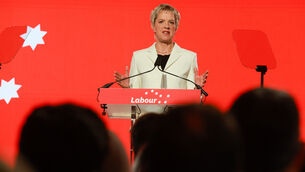Why voters are looking askance at Sinn Féin’s leadership

Sinn Féin’s Westminster abstentionist policy, the lack of an Assembly in the North, and absence from 2016 government formation talks have created a bad smell, writes Daniel McConnell
THIS weekend, the Sinn Féin faithful are gathering in Derry for their ard fheis.
However, unlike previous times, when the mood was upbeat, the party is in a slump.
It got its backside handed to it at the local and European elections, its vice-president is facing a challenge to her position, and the party’s relevance, North and South, is in question, given their failure/refusal to take seats in two of the three parliaments to which they are elected.
Such is the party’s woe, there are building fears that it could lose up to half of its seats in the Dáil come next May’s general election.
Since Gerry Adams’s decision to stand down and Martin McGuinness’s death, the party has gone into reversal.
Mary Lou McDonald, the highly impressive number two under Adams, has found the elevation to the top job much harder than anyone foresaw. Her Northern-based deputy, Michelle O’Neill, has never appeared authoritative and has struggled to establish herself.
To use a sporting analogy, both McDonald and O’Neill have looked decidedly David Moyes-esque, compared to their Alex Ferguson-type predecessors.
In Derry, O’Neill is facing a challenge for her job at the ard fheis from MLA for Upper Bann, John O’Dowd, who has been a member of Sinn Féin for over 30 years.
Around 2,000 party members will cast their vote as to who should be the party’s vice-president. The result is expected to be made known before McDonald takes to her feet and makes her keynote address this evening.
For so long under the Adams and McGuinness era, such an event would have been unheard of.
For Sinn Féin’s TDs, senators, and even their leader, Mary Lou McDonald, the devastating defeat they suffered at last May’s local and European elections came out of the blue.
Heading into those elections, in most constituencies, the party had expected to hold and, in some cases, increase, its vote and its councillors.
Having won 159 council seats in 2014, a rise of 105, the increases were expected to be modest, but doable. The party also saw two of its three MEPs — Lynn Boylan, in Dublin, and Liadh Ní Riada, in Ireland South — lose their seats. Only Matt Carthy survived, with a much-reduced vote.
No-one saw the collapse. No-one saw the loss of 78 seats. Across the country, the backlash was not being picked up by TDs, senators, and those knocking on doors.
But when the ballot boxes were opened, a major shock was in store.
“It was a shock. We didn’t see it coming. This was not coming up on the doors,” said Dublin Fingal TD and health spokeswoman, Louise O’Reilly.
“Nobody thought it was going to be this bad. Had we picked it up on the doors, we would have changed direction or tone. But it was a disaster,” said one TD.
Some panicked; others flipped-out, thinking the end was nigh.
The truth of the matter is that most of the gains made in 2014 were lost.
“We lost them all,” said one TD.
But where did that vote go?
The party, which captured huge swathes of working, lower middle class, and “squeezed middle” votes in 2014, off the back of the water charges controversy, saw them all depart to other parties this time around.
The water charges issue was a huge calling card to working class voters, who saw Sinn Féin as the most obvious candidates to support.
This time, some of that vote went to Labour, some to the Soc Dems, some to Independents, and, in some areas, the vote just fell away.
Party officials have said they need to work out quickly why those voters who flocked to them in 2014 fled this time around.
Were this to be replicated in a general election, the party would be back to where it was in 2011, down from the 23 seats they currently have in the Dáil to about half of that.
Speaking honestly, some of the party’s biggest hitters have accepted that the conflation of the abstentionist policy in Westminster, the lack of an Assembly in the North, the absence of the party from government formation talks in 2016, and the bullying abuse scandals have merged to create a bad smell.
Some TDs argued that each issue in isolation is debatable and defendable, but when wrapped in together, it is clear that they were a put-off to voters.
Added to all that, the party is also likely to struggle to challenge for any of the four by-elections on Friday, November 29, which will only emphasise their fading influence.
With the McDonald project in a state of crisis, there are increasing mutterings that her time at the top will be cut short, should the party reduce in size in the Dail, remain in limbo in the North, and lose any of its seats in Westminster.
McDonald’s elevation to the top was well-flagged, but the future for her and her party looks far less assured.
Amid those mutterings of change of leader, one name above all others is being whispered: that of Pearse Doherty.
Well-liked internally and respected across the political spectrum, Doherty, Sinn Féin’s Dáil deputy leader, has grown in stature while his leader has appeared to fall back.
He forced the by-election in Donegal in 2010 and changed the law in doing so, which now requires by-elections to be held within six months of a seat being vacated.
Re-elected in 2011 and 2016, Doherty’s star has been on an upward path.
During the 2016 general election campaign, amid all the farcical talk of fiscal space, it was Doherty, and not Michael Noonan or Michael McGrath, who had his sums correct.
His performances both in the Dáil and at finance committee have caught the eye.
Doherty’s recent filleting of the insurance industry, over their ludicrous statements relating to fraudulent claims, won him considerable praise.
His background, too, hints at a willingness to be more inclusive and progressive than some of his party colleagues.
“My mother voted Fine Gael and my father voted Fianna Fáil. He wasn’t very active, but he would have canvassed and for the Leas-Cheann Comhairle, Pat The Cope,” he recently said in an interview.
His expression of republicanism is far more nuanced than the old-school “Brits out” slogan usually associated with the Shinners.
According to some in the party, Doherty is seen as a far more credible force up North, given his Donegal base, and one TD has suggested he could even see Doherty as a single, unified leader.
The elections in May have spooked the Sinn Féin machine and general elections on both sides of the Irish Sea within the next seven months will determine a lot.
But, it is very clear some within the party are already looking beyond McDonald to what life could be like with Doherty as their new king.














